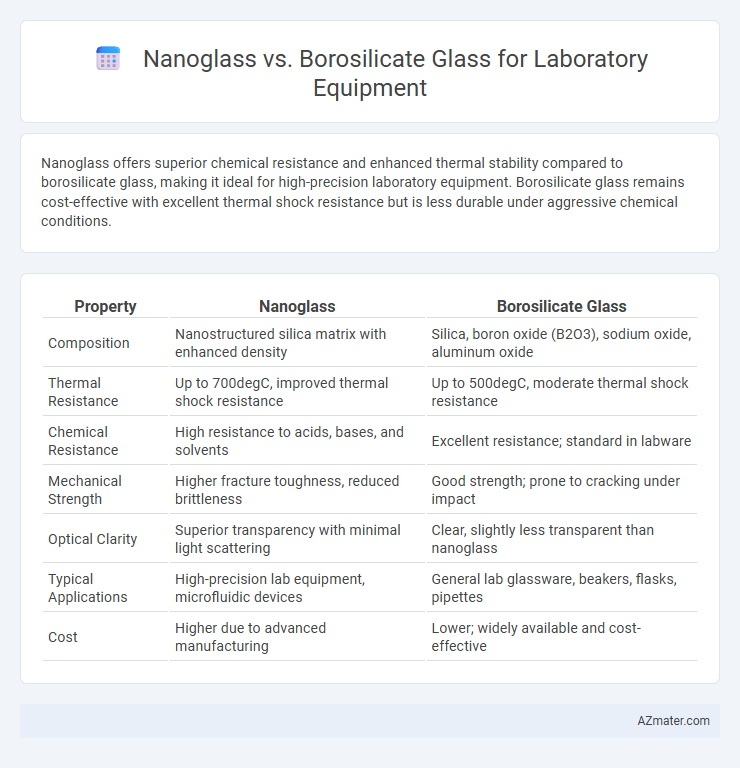Nanoglass offers superior chemical resistance and enhanced thermal stability compared to borosilicate glass, making it ideal for high-precision laboratory equipment. Borosilicate glass remains cost-effective with excellent thermal shock resistance but is less durable under aggressive chemical conditions.
Table of Comparison
| Property | Nanoglass | Borosilicate Glass |
|---|---|---|
| Composition | Nanostructured silica matrix with enhanced density | Silica, boron oxide (B2O3), sodium oxide, aluminum oxide |
| Thermal Resistance | Up to 700degC, improved thermal shock resistance | Up to 500degC, moderate thermal shock resistance |
| Chemical Resistance | High resistance to acids, bases, and solvents | Excellent resistance; standard in labware |
| Mechanical Strength | Higher fracture toughness, reduced brittleness | Good strength; prone to cracking under impact |
| Optical Clarity | Superior transparency with minimal light scattering | Clear, slightly less transparent than nanoglass |
| Typical Applications | High-precision lab equipment, microfluidic devices | General lab glassware, beakers, flasks, pipettes |
| Cost | Higher due to advanced manufacturing | Lower; widely available and cost-effective |
Introduction to Laboratory Glass Materials
Nanoglass and borosilicate glass represent two distinct categories of laboratory glass materials used for precision equipment. Borosilicate glass is renowned for its excellent thermal resistance, chemical durability, and low coefficient of thermal expansion, making it the traditional choice for laboratoryware such as beakers and flasks. Nanoglass, incorporating nano-engineered structures, offers enhanced mechanical strength, improved chemical resistance, and increased fracture toughness, positioning it as a cutting-edge alternative for advanced laboratory applications requiring superior durability and longevity.
What is Nanoglass?
Nanoglass is an advanced form of glass engineered at the nanoscale to enhance mechanical strength, chemical durability, and thermal resistance compared to traditional laboratory glass. Unlike borosilicate glass, which is composed primarily of silica and boron trioxide providing good thermal stability and chemical resistance, nanoglass features a unique nanostructured composition that offers superior fracture toughness and impact resistance. This makes nanoglass ideal for laboratory equipment requiring high-performance materials capable of withstanding extreme conditions and reducing the risk of breakage.
Overview of Borosilicate Glass
Borosilicate glass is a highly durable material widely used in laboratory equipment due to its excellent thermal resistance and chemical stability. Its low thermal expansion coefficient minimizes the risk of cracking during rapid temperature changes, making it ideal for laboratory glassware like beakers, flasks, and test tubes. This glass composition primarily consists of silica and boron trioxide, which enhances its resistance to acids, bases, and solvents commonly encountered in scientific experiments.
Chemical Resistance: Nanoglass vs Borosilicate Glass
Nanoglass offers superior chemical resistance compared to borosilicate glass, with enhanced durability against strong acids, alkalis, and organic solvents commonly used in laboratory environments. Borosilicate glass, while highly resistant to thermal shock and many chemicals, can degrade over time when exposed to highly aggressive reagents such as hydrofluoric acid. Laboratories requiring long-term exposure to harsh chemicals benefit from Nanoglass's advanced molecular structure, which minimizes leaching and corrosion, ensuring more reliable and safer experimental results.
Thermal Stability and Performance
Nanoglass exhibits superior thermal stability compared to borosilicate glass, withstanding rapid temperature changes up to 800degC without cracking, ideal for high-precision laboratory applications. Borosilicate glass offers good thermal resistance up to approximately 450degC but is more prone to thermal shock under extreme conditions. The enhanced thermal performance of nanoglass ensures improved durability and longevity in demanding experimental environments.
Mechanical Strength Comparison
Nanoglass exhibits significantly higher mechanical strength compared to borosilicate glass, making it more resistant to scratches, impacts, and thermal shock in laboratory environments. The superior fracture toughness and enhanced hardness of nanoglass result from its nanoscale grain structure, which inhibits crack propagation more effectively than the amorphous network of borosilicate glass. This mechanical advantage leads to increased durability and longer service life of laboratory equipment made from nanoglass, especially under rigorous experimental conditions.
Transparency and Optical Clarity
Nanoglass offers superior transparency and exceptional optical clarity compared to borosilicate glass, making it ideal for precise laboratory applications requiring high-resolution visualization. Borosilicate glass provides good chemical resistance and durability but exhibits slightly lower light transmission and minor scattering at microscopic levels. Enhanced optical properties of nanoglass reduce distortion and improve accuracy in spectroscopic and microscopic analysis.
Compatibility with Laboratory Processes
Nanoglass exhibits superior resistance to chemical corrosion and thermal shock compared to borosilicate glass, making it highly compatible with aggressive laboratory reagents and rapid temperature changes. Borosilicate glass, widely used in laboratories, performs well under moderate thermal and chemical stress but may degrade faster when exposed to highly alkaline or acidic substances. The enhanced durability and inertness of nanoglass contribute to longer-lasting equipment and reduced contamination risks in precise analytical procedures.
Cost and Availability Factors
Nanoglass is typically more expensive than borosilicate glass due to its advanced nanostructured composition, which enhances durability and thermal resistance. Borosilicate glass remains widely available and affordable, making it the preferred choice for most laboratory equipment where cost-effectiveness is crucial. The limited production scale of nanoglass contributes to its higher price and reduced market availability compared to the well-established supply chain of borosilicate glass.
Choosing the Right Glass for Your Laboratory Needs
Nanoglass offers superior chemical resistance and enhanced thermal stability compared to traditional borosilicate glass, making it ideal for high-precision laboratory applications that require durability under aggressive conditions. Borosilicate glass remains a cost-effective choice with excellent thermal shock resistance and good chemical resilience, suitable for general laboratory use. Selecting the right glass depends on specific laboratory needs such as temperature range, exposure to corrosive substances, and budget constraints.

Infographic: Nanoglass vs Borosilicate glass for Laboratory equipment
 azmater.com
azmater.com